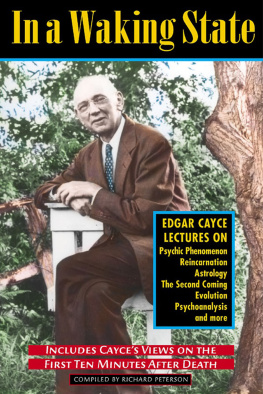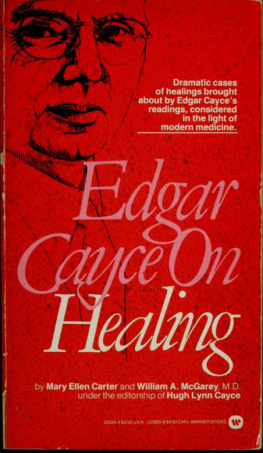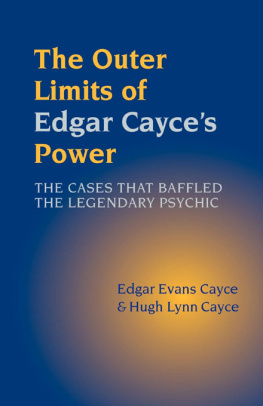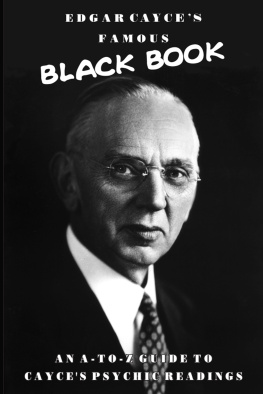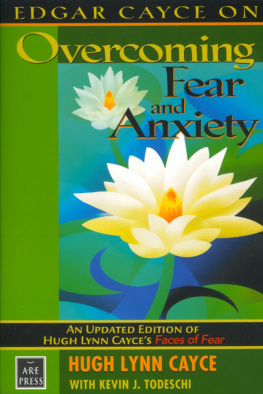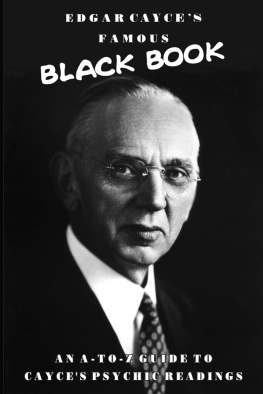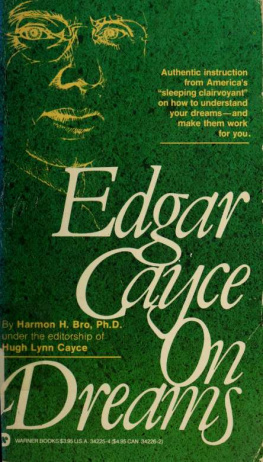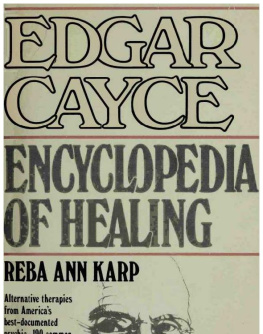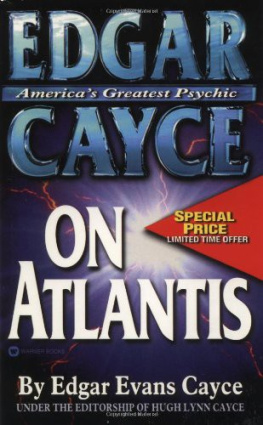
In a Waking State
THE EDGAR CAYCE LECTURES
In a Waking State
THE EDGAR CAYCE LECTURES
Compiled and Edited by
Richard O. Peterson
With a Foreword by
Charles Thomas Cayce
A.R.E. PressVirginia BeachVirginia
Copyright 2004
by the Edgar Cayce Foundation
3rd Printing, November 2009
Printed in the U.S.A.
All rights reserved. No part of this book may be reproduced or transmitted in any form or by any means, electronic or mechanical, including photocopying, recording, or by any information storage and retrieval system, without permission in writing from the publisher.
A.R.E. Press
215 67th Street
Virginia Beach, VA 23451-2061
Library of Congress Cataloguing-in-Publication Data
Cayce, Edgar, 1877-1945.
In a waking state : Edgar Cayce lectures / compiled by Richard O. Peterson : foreword by Charles Thomas Cayce.
p.cm.
Includes bibliographical references.
ISBN 13: 978-0-87604-489-6 (trade pbk.)
1. Parapsychology. 2. Occultism. I. Peterson, Richard, 1928- II. Title.
BF1031.C47 2004
133.8dc22
2004025019
Quotations from Edgar Cayce: American Prophet by Sydney D. Kirkpatrick: Copyright 2000 by Sidney D. Kirkpatrick. Used by permission of Riverhead Books, an imprint of Penguin Group (USA) Inc.
Quotations from Edgar CayceMy Life As a Seer: The Lost Memoirs: Copyright 1999 by Edgar Cayce Foundation, from My Life As a Seer: The Lost Memoirs of Edgar Cayce, compiled and edited by A. Robert Smith. Reprinted by permission of St. Martins Press, LLC
Edgar Cayce Readings 1971, 1993-2007
by the Edgar Cayce Foundation.
All rights reserved.
Cover design by Richard Boyle
CONTENTS
by Charles Thomas Cayce
by Richard O. Peterson
Foreword
T he spiritual wisdom of my grandfather, Edgar Cayce, has been largely assembled and disseminated from the information and ideas recorded during his psychic readings between 1900 and 1945. Most of the books and articles about his work and philosophy are based on that information, channeled through him during a sleep-like trance. He did not consciously hear the information at the time the readings were given nor did he later recall it.
Yet he developed his own personal belief systemnot only from his study of the recorded readings, but also from his faithful study of the Bible and other resources, from his own challenging life experiences, and from his interactions with those he encountered around him. Perhaps the most complete expression of his personal beliefs is represented in his public lecturesespecially those given frequently during the period that included both the realization of his dream of a hospital and the subsequent loss of that hospital amidst much conflict and personal sacrifice. Perhaps coincidentally, his lecturing virtually ceased when he began an outreach alternative that resulted in a ten-year series of readings on lessons for developing personal spirituality through A Search for God.
This book contains most of the known public lectures delivered by Edgar Cayce. These lecturesthirty in allwere delivered between 1929 and 1935, most of them on Sunday afternoons during the crucial period of his life and work from late 1929 through 1931. The lectures present many of the spiritual and metaphysical ideas now considered the foundation of the work of Edgar Cayce.
The lectures do more than summarize key principles and ideas. In fact, these lectures are the best expression we have of Edgar Cayces personal understanding and beliefs about these fundamental ideas and issues. You will sense that Cayce is not just presenting information in a tutorial style. In his desire to help his listeners change their lives for the better, Cayce frequently urges them to take the information to heart and apply it in their own lives. He is clearly an enthusiastic advocate for the life-shaping principles.
What he is advocating to his listeners during this period is significantly different from what he would have said to them before 1923 when his own spiritual views were challenged by startling information that began to appear that year. Readings requested by friend Arthur Lammers included information on such topics as reincarnation, the soul and its destiny, psychic ability and psychic phenomena, astrology, levels of consciousness, and dreams. Another friend of the work, Morton Blumenthal, not only became fascinated by these topics, but requested personal readings on many of themespecially in 1925. The information from the Lammers and Blumenthal readings was elaborated upon over the rest of Cayces life, often in readings requested for another purpose including those that came to be called life readings. Thus, the lectures in this collection summarize Cayces beliefs regarding these fascinating topics during this critical period of his work.
When he gave his first lectures in 1929, Edgar Cayce was a novice at lecturingand I believe that shows in these transcripts. We have retained the flavor of the original lectures (most recorded by unspecified persons), while reducing some of the confusion of self-interruption, unintentional repetition, and probable misunderstanding of words by the unnamed reporters.
Throughout most of his life, Edgar Cayce relied deeply on his beloved Bible. In his lectures, he frequently referred to biblical people and events to help explain or illustrate his ideas. We have added Bible citations for most of the references in his lectures, so the interested reader may go to the Bible to review the complete story and context.
This is the third book presenting Edgar Cayce in his own wordsas separate from the readings themselves. The two previous books are:
Edgar CayceMy Life As a Seer: The Lost Memoirs
The Work of Edgar Cayce As Seen Through His Letters
I hope you enjoy reading what the awake Edgar Cayce said about these timeless ideas. I hope these lectures will stimulate you to read (or reread) other material on the subject that will help make these ideas meaningful and useful in your own life.
Charles Thomas Cayce
Executive Director, Association for Research
and Enlightenment, Inc., and President,
Edgar Cayce Foundation
Introduction
Edgar Cayce, the Lecturer
I n 1929, when Edgar Cayce began giving a series of Sunday afternoon lectures at his new hospital in Virginia Beach, lecturing was a relatively new experience for him. He was now on his feetliterally or figurativelyexpressing to a public audience many of the spiritual and metaphysical ideas he had formulated in his conscious mind from his study of the readings and of the Bible, as well as from other sources. Lecturing contrasted with his usual reading session during which he reported what he received as an unconscious channel while lying in a prone position in front of a small group of interested people. Before this series of lectures, he had occasionally talked to groups of interested members, especially when he traveled, but he never took on the formal role of lecturer until 1929.
Cayce reported having had a dream that seemed to foretell (his word) his lecture activity:
Next page
